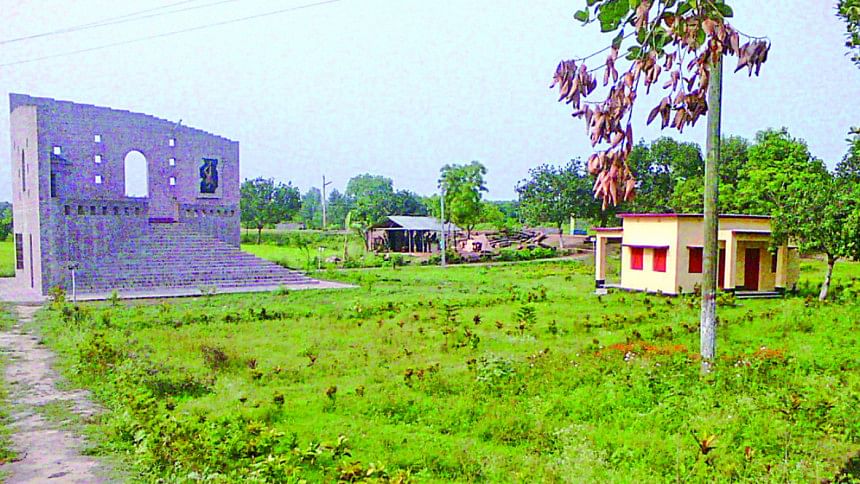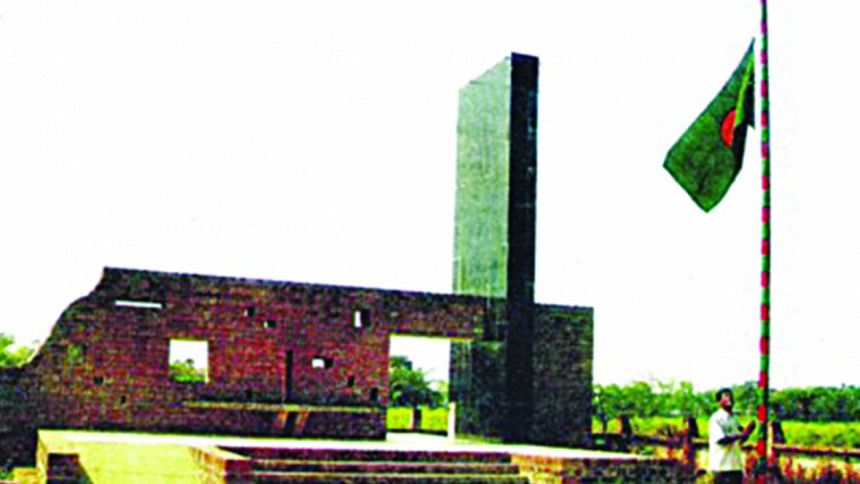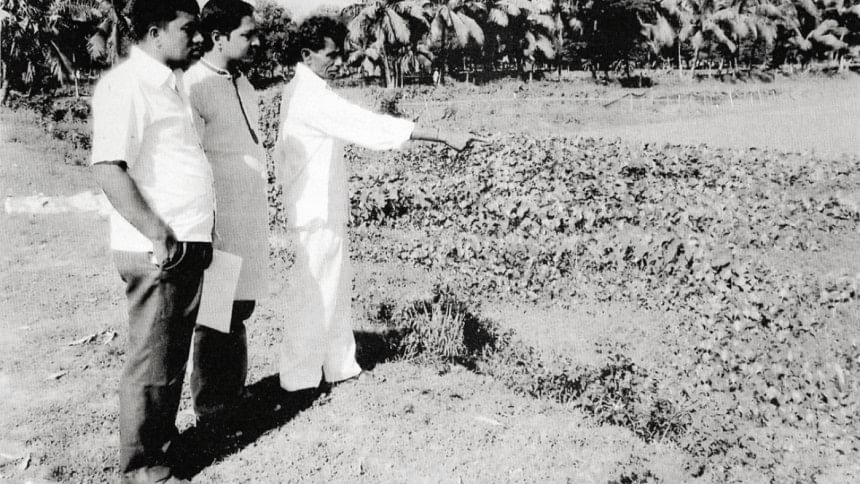A HISTORY WRITTEN IN BLOOD

On March 25, 1971, more than 18,000 Pakistani soldiers aided by 75 tanks, jet fighters, combat helicopters and around 5,000 paramilitary forces invaded Bangladesh (erstwhile East Pakistan) to destroy its people's movement of self-determination. Their objective was to storm the major cities and strategic towns of the country with ruthless military assaults from the ground, air and water and take control of those areas from the Bangalee nationalist leaders who were elected during the general election of 1970. It was the infamous 'Operation Searchlight' that initiated the nine-month long Liberation War of Bangladesh and paved the way for some of the most brutal massacres of human history.
Operation Searchlight itself was designed as a genocidal military assault that would use terror as a weapon to crush the civilian movement. Soldiers were instructed by their officers to conduct calculated brutality against civilians so that they could never raise their voice against Pakistani occupation. While secretly preparing the army for the assault, General Yahya Khan, the then President of Pakistan, addressed his soldiers at a conference in February 1971 and said, “Kill three million of them (Bangladeshis) and the rest will eat out of our hands.” During the operation, General Tikka Khan, the then chief of Pakistan army's eastern command, ordered his soldiers, “I want the land and not the people.”
As a result, several hundred thousand Bangalee civilians were killed within the first few days of Operation Searchlight. Even General AAK Niazi, the successor of Tikka, wrote in his memoirs titled The Betrayal of East Pakistan, “The military action was a display of stark cruelty, more merciless than the massacre at Bakhura and Baghdad by Changez Khan and Halaku Khan and at Jalianwala Bagh by British General Dyer.”

However, this was only the beginning. After taking control of all the cities and towns in the country, the Pakistani occupation army reorganised to launch counter-insurgency operations across the country. Under the cover of this counter insurgency operation, the Pakistan army massacred millions of innocent Bangali civilians during the course of the Liberation War. Besides the killing sites of Dhaka such as Rayer Bazaar, Mohammadpur and Mirpur, there are thousands of killing fields all around Bangladesh which still bear the testimony of the brutal genocide carried out during the Liberation War.
In three of the largest killing sites of the country, thousands of our countrymen have been tortured and killed. However, tragic realities common to these sites are that they are some of the least mentioned and under preserved sites, and none of the perpetrators who committed crimes there faced any trial.
One of these killing fields is located in a remote part of Khulna's Dumuria sub-district. The area is called Chuknagar. After Operation Searchlight, hundreds and thousands of fleeing Bangalees arrived in Chuknagar as it was one of the few remaining transit routes to the Indian border.
According to witness accounts, on May 20, 1971, Pakistani troops loaded in three trucks arrived at Chuknagar bazaar and found the gatherings of thousands of refugees. They started to fire indiscriminately at the fleeing people with their machine guns and semi-automatic rifles. After eliminating them, the soldiers stormed the nearby villages and gathered several thousand people on the banks of the Bhodra River. Then they emptied their machine guns on those hapless villagers.
Pakistani soldiers ordered the remaining villagers to throw the dead bodies into the river without any funeral. One of the witnesses, Anser Ali, says, “There were bodies over bodies, thousands of bodies. I did not get any space to step out by-passing the blood-stained bodies.”
According to the witnesses, 8,000 to 10,000 Bangalees were shot in cold blood by the Pakistani soldiers at Chuknagar. However, this massacre was almost forgotten by the war historians of the Liberation War and was not mentioned anywhere in the state-published 15-volume Documents of the Liberation War. Only recent research revealed this forgotten tragedy and a memorial has been erected at the site of the massacre.
However, the exact number of the massacred and their identities could not be known as no effort was made to unravel this tragic event in our history beyond the erection of the memorial. Brigadier Mohammad Hayat, whose troops committed this massacre, was listed as one of the 195 Pakistani war criminals but never faced any trial.
Another large killing site which is hardly mentioned in the historical accounts of the Liberation War is located at Alamdanga town of Chuadanga district. The site is a low-lying area adjacent to a massive railway bridge connecting northern Rajshahi district with the southern part of the country. During the war, there was a strong Pakistani garrison guarding the bridge and the adjacent area. Pakistani troops established their position in the area in June, 1971. From then until December 7, 1971, they killed thousands of Bangalees and buried them in the low-lying field adjacent to their camp. They systematically destroyed all the nearby villages and killed villagers in the name of counter-insurgency operation.
Pakistani soldiers used to stop passenger trains and buses routinely checking for freedom fighters and fleeing refugees. They took the suspects to their camp, tortured them and threw their dead bodies into the ditch. Sometimes they buried their half dead victims alive with other corpses. There was a special torture cell for the female prisoners where Pakistani soldiers had raped thousands of Bangalee women.

After the liberation of the area on December 7, 1971, freedom fighters found hundreds of decaying dead bodies lying in the ditch. While burying the dead bodies, they discovered numerous skeletons of men, women and children in the ditch. It is assumed that around three thousand people were killed alone in this site during the seven months of Pakistani occupation. (Source: Alamdangar Boddhobhumi by Emran Mahfuz)
This killing site is well-known for its horrible past among the local residents. The freedom fighters who discovered the area still recall the day with shock and horror. A memorial is being built on the killing site. The one-storey building which was used as a torture cell by the Pakistani soldiers is now being used as a government office. All three commanding officers of this garrison, Lt. Colonel Abdul Ghaffor, Major Rana Mohyydin Khan and Captain Muzaffar Hossain Naqvi, have been listed among 195 Pakistani war criminals. However, none of them faced trial for their heinous crimes.
Beltoli is another of the largest killing sites where at least 2000 people were killed by the Pakistan army during the Liberation War. One of the witnesses of the massacre, Sridham Das, said that he had seen 30-35 dead bodies buried everyday in this killing site which is now almost covered by a swampy area filled with hyacinths.
Few days after the crackdown on March 25, Pakistani soldiers established their garrison at a cigarette factory near the strategically important Laksham railway station. This garrison was particularly notorious for torturing and killing thousands of Bangalee women kidnapped from the nearby villages and towns. Aided by the Bihari collaborators, Pakistani troops led by their sadistic officers, Major Muzaffar Hassan Gaddarji and Captain Obaidur Rahman, used to raid villages and towns every other day to hunt down freedom fighters and kidnap women. Workers of the factory and the railway station were forced to bury their victims at the killing site. One of the workers, Sridham Das, is still alive and had buried thousands of men and women killed by the Pakistani soldiers. Sometimes Pakistani soldiers even forced him to bury tortured people alive.
According to his account, usually before mass shooting the arrested people, Pakistani troops used to force the villagers to gather at the killing site. Then in front of the crowd, they used to shoot their captives and warned the crowd that this would be the consequence of collaborating with the freedom fighters.
After the war, the cigarette factory was sealed by the allied forces. A local journalist visited the factory in 1972 and published his account in the February 10, 1972 issue of the weekly Amod. He said, “After entering the factory the smell of rotting flesh and blood struck my nose. This was coming from half-buried dead bodies all around the premises of the factory. I saw torture equipment and gallows where Pakistani soldiers used to hang Bangalis.” (Source: Beltoli Genocide by Mamun Siddiqui; 1971; Genocide-Torture Archive & Museum Trust)
However, like all other Pakistani war criminals, the commanders of this garrison also enjoyed safe exit to Pakistan after the war and faced no trial for their war crimes. Even due to its remote location Beltoli killing field was also overlooked by the war historians and the government. A large part of the killing site is under the marsh covered by water hyacinths where skeletons of many victims can still be found. A memorial is now under construction beside the killing field. Construction workers said that they have found bones and remnants of human bodies while digging the basement of the memorial.
There are few nations in the world who have achieved liberty at the cost of such a brutal war like the Liberation War of Bangladesh. Thousands of killing sites all over the country stand witness to genocide that is considered one of the most violent incidents of human massacre (if not the most) after the Holocaust of World War II.
However, the most unfortunate fact is that all the key perpetrators of the genocide, the listed 200 Pakistani war criminals who became the prisoners of war after the liberation of Bangladesh, were safely transported to Pakistan by the allied Indian army where those war criminals were rehabilitated with full state facilities. On the other hand, Bangladesh became politically divided where history and legacy of the Liberation War has been distorted. If we simply erect a monument at these sites while being forgetful to the cause, then we shall be doing great injustice to the nation by burying the truth of what truly happened and why.
The writer is a feature writer of the Star Weekend and can be contacted at [email protected].

 For all latest news, follow The Daily Star's Google News channel.
For all latest news, follow The Daily Star's Google News channel. 



Comments